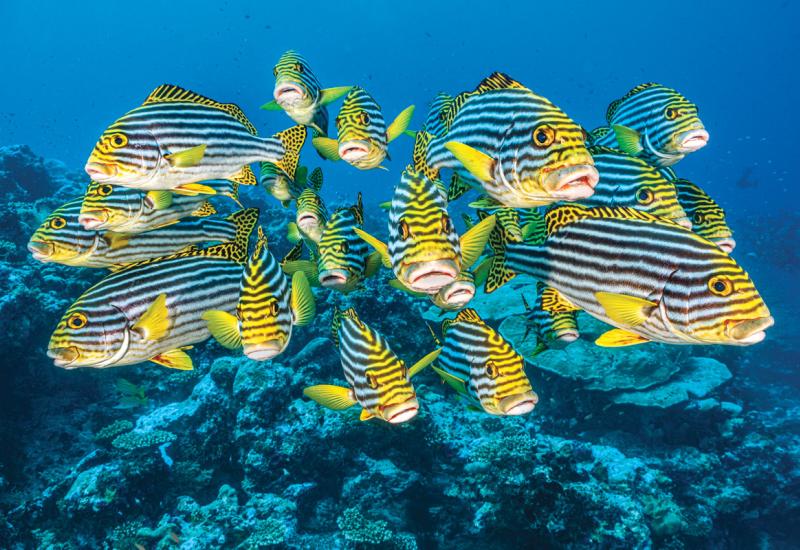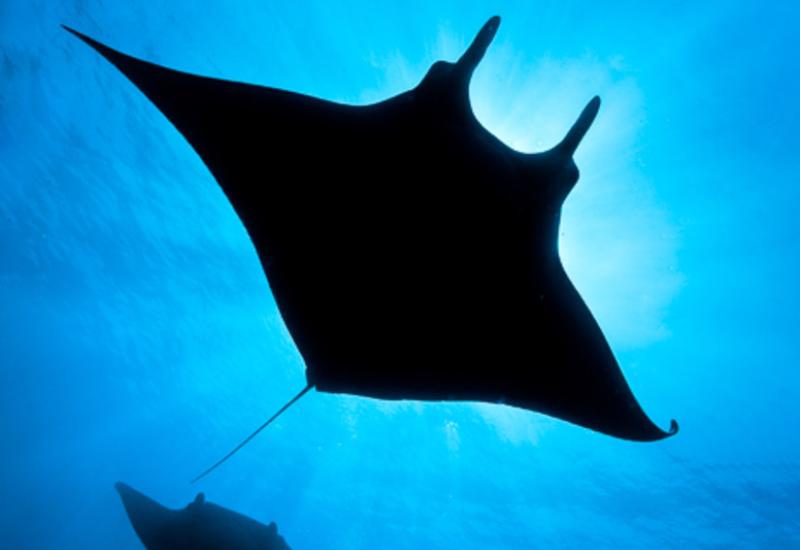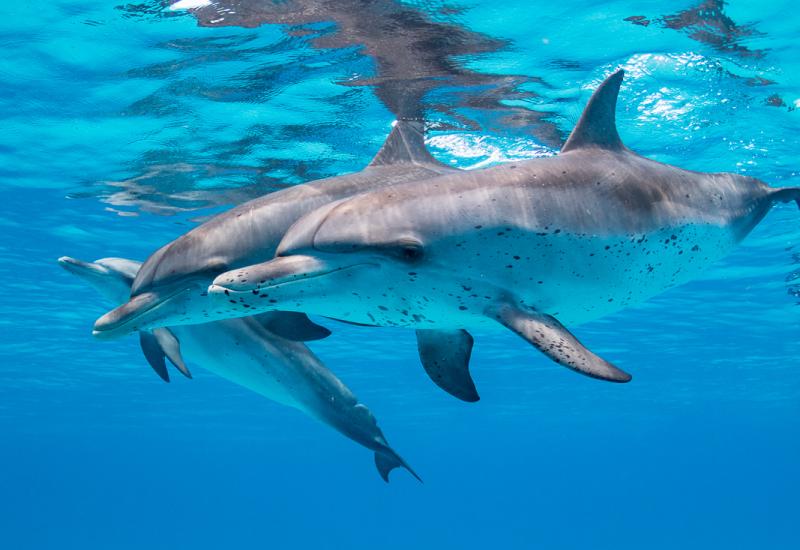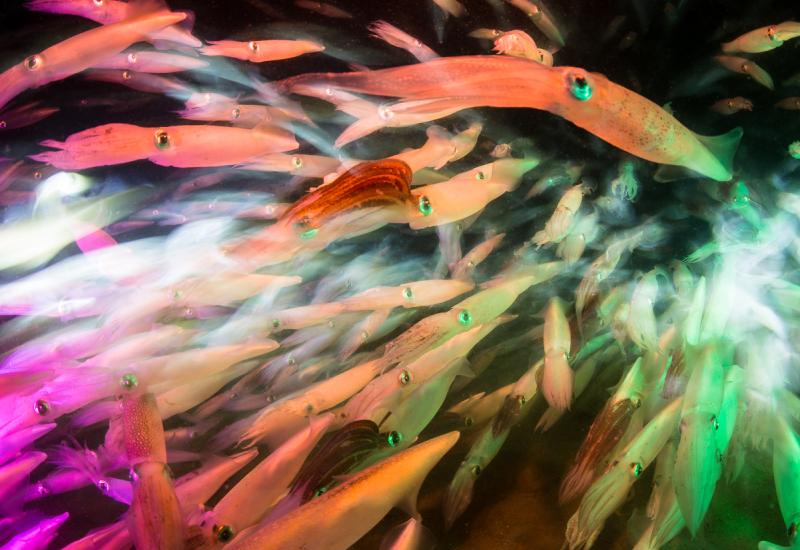Surviving a Wide-Angle Photography Bootcamp
Divers like to learn. For some, earning multiple certs is like counting coup, and there’s no bigger “get” than becoming an accomplished underwater photographer. How to begin? Spend a week with experts from Backscatter Underwater Video & Photo.
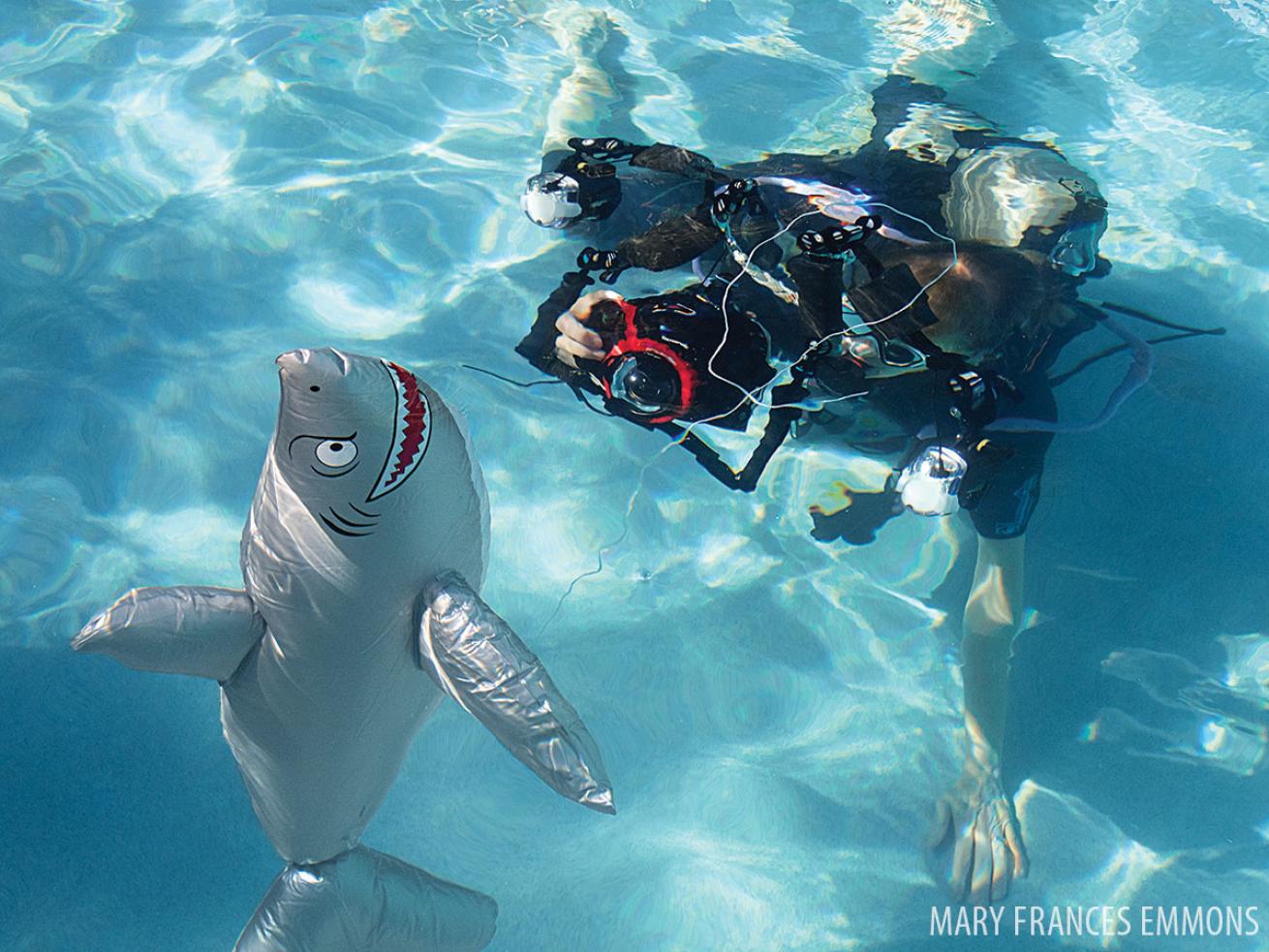
Mary Frances EmmonsA tethered “shark” makes a friendly subject.
Tomorrow we’re getting in the pool with some sharks.” Whaaa? That pool? We’re at Little Cayman Beach Resort, where 13 would-be wide-angle shooters have gathered to soak in all that two instructors from Backscatter Underwater Video & Photo can teach us in a week of close-focus wide-angle “boot camp.” Backscatter CEO Jim Decker and digital/postproduction instructor Erin Quigley have their work cut out. A lifelong amateur shutterbug , I have held a DSLR underwater exactly twice. With unimpressive results. Decker has loaned me a Canon 7D Mark II system, so I’m also nervous that I’m going to destroy the sarge’s rig. No pressure, right?
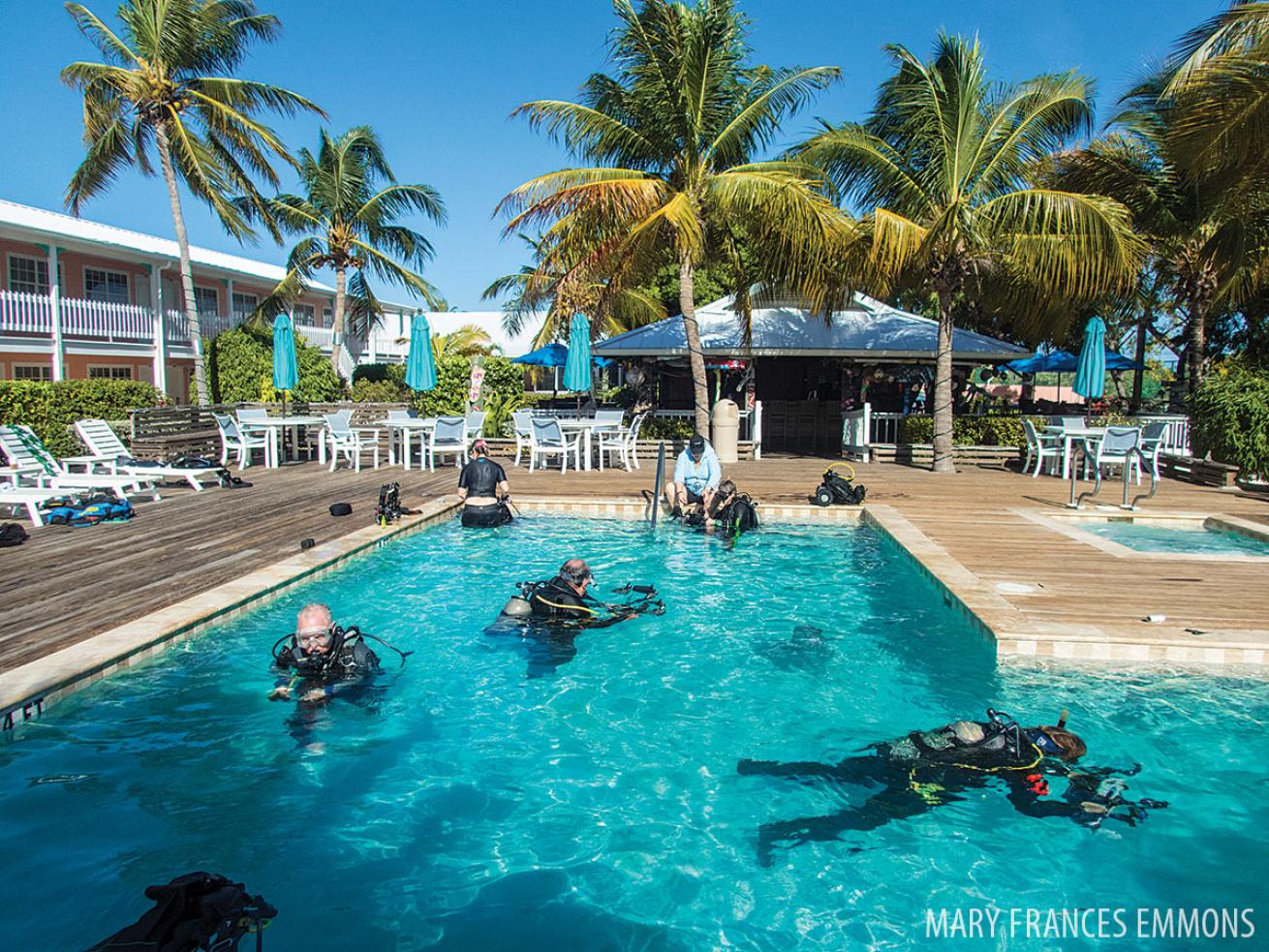
Mary Frances EmmonsWant to enlist? Decker and Quigley will lead a wide-angle boot camp at Little Cayman Beach Resort in April.
DAY ONE
[5 p.m. Saturday] I’m here! Housing is not. Didn’t make the jump from Grand Cayman. Nobody’s worried, it happens — we’re on Cayman time now, mon, it will show up. It does.
We bring our rigs to Decker and Quigley to check setups, then we’re released until dinner. After a quick pass through the resort’s Beach Nuts Bar — what’s more fun than drinking in class? — we move on to our introductory session, where Decker explains that we are here for one reason. The boot-camp approach — morning dives with in-water help, paired with afternoon classroom instruction and nightly critiques — is about “singleness of purpose”: Do one thing until you get good at it. Quigley, leading the afternoon sessions, will induct us into the mysteries of Lightroom, Adobe’s near-magical image-management and editing program. “Do exactly what I tell you and you’ll be fine,” she says.
DAY TWO
[9:30 a.m. Sunday] “Can you touch it?” Decker is in the pool coaxing a trainee to get closer to a shark-shaped inflatable. “The only thing you can light is what you can touch,” Quigley adds from the pool deck. Truer words have not been spoken.
Early afternoon and we head for the boat and a site called Mixing Bowl. “There are a lot of us,” Quigley reminds, “and we’re shooting wide-angle. People will get in your shot; if you see their dome, you are in their shot. Put your legs together and look pretty or get out.” We’re looking for sponges — cooperative subjects, if not terribly dynamic. Baby steps. Decker and Quigley will look for good setups and move among us to give suggestions. The first few dives will be focused on getting used to the “mindset of wide angle,” Quigley says, telling us to move our strobes on every setup: Take 10 pictures, then move ’em again. Think of wide-angle not as a two-dimensional form, she says; try to bring the viewer’s eye to the specific place in the picture you want it to go. Experiment. I strike out across a fi eld of many, many barrel sponges, and immediately spy a good-size Caribbean reef shark. Automatically the camera comes up and … stick with the sponges, girlfriend. I feel uncertain, at loose ends, like I’m not sure what I’m doing — a feeling I’m not used to underwater. This is more challenging than it looks. On the second dive, at a Jackson’s Bight site called Ann’s Attic, the camera gets stuck in live view. How, I have no idea.
[6:39 p.m.] Late for dinner ’cause I can’t figure out how to break the seal on the &%^$@# housing. I know I’m pulling on the right knob…. I give up and interrupt Quigley at a well-deserved happy hour. Pull UP, she says. Doh. I knew that.*
After dinner we gather for “Successful Wide-Angle,” the first of several lectures from Decker. He repeats what will become our mantra: Shoot. Review. Adjust. Repeat. “When you think you have the perfect shot,” he says, “take 20 or 30 more,” while admonishing us to avoid “reef barf” — shots that have no discernible subject. There follows a great deal of info about a great many subjects, so much that it’s a little overwhelming. “Like drinking from a firehose,” one student says.
[11:11 p.m.] Images stored, card reformatted, housing reassembled and … strobes won’t fire. My images suck and I am frustrated to tears. I am not going to cry. I am crying. I want to go home.
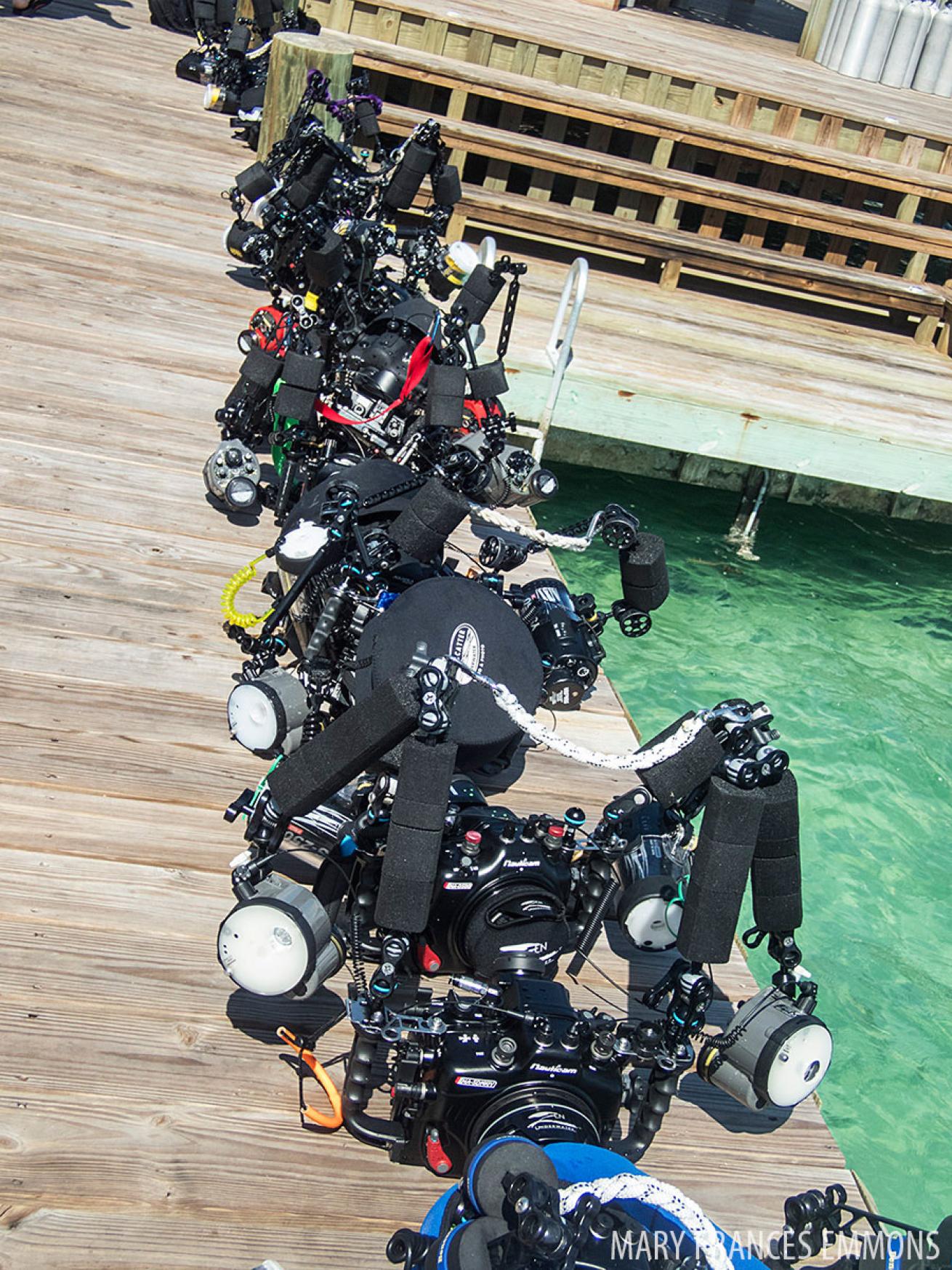
Mary Frances EmmonsAll lined up and ready to dive at Little Cayman Beach Resort.
DAY THREE
[7 a.m. Monday] A glorious new day! I stake out the dining hall, hoping to snag Decker or Quigley, but instead I encounter my warmly encouraging fellow students, who know exactly what I have done wrong (internal flash not popped up, a common rookie mistake). Hallelujah! Back in business and ready to dive.
Decker gives us our assignments: Properly light a vertical, and get a buddy with a sponge — one strobe lighting each. “Unlit reef does not count as background,” he says. “Discernible” is the word of the week. Pay attention to your least-cooperative subject. I’m guessing that will not be the sponge. For the rest of the week, students can choose between an extra afternoon dive for in-water help from Decker, or more Lightroom indoctrination with Quigley. I should be out there on the reef, given my abysmal skill level, but I’m drawn hypnotically to Lightroom. “It’s sexy for image editing,” Quigley says — an understatement — “but its real power is organization.” Editing is subjective. “This is your image. It’s about how you want it to look.”
[7:45 p.m.] Our first critique! Who will be voted off the island????
The advice flies — and the laughs. Shots of a dead lobster — its molted carapace, really — have everyone in stitches, as well as an oddly foreshortened perspective on a diver. “Toulouse-Lautrec!” Quigley blurts, and everyone howls. Quigley and Decker are blunt, and funny, but the goal is to empower us to make better pictures. While Decker explains why a different setting or strobe position might have worked better, Quigley works her alchemy, demonstrating with Lightroom what each shot could have looked like. But there’s stuff even Lightroom can’t fix, and that’s why we’re here: to learn to make the best possible image in camera, and then use Lightroom to make it even better.
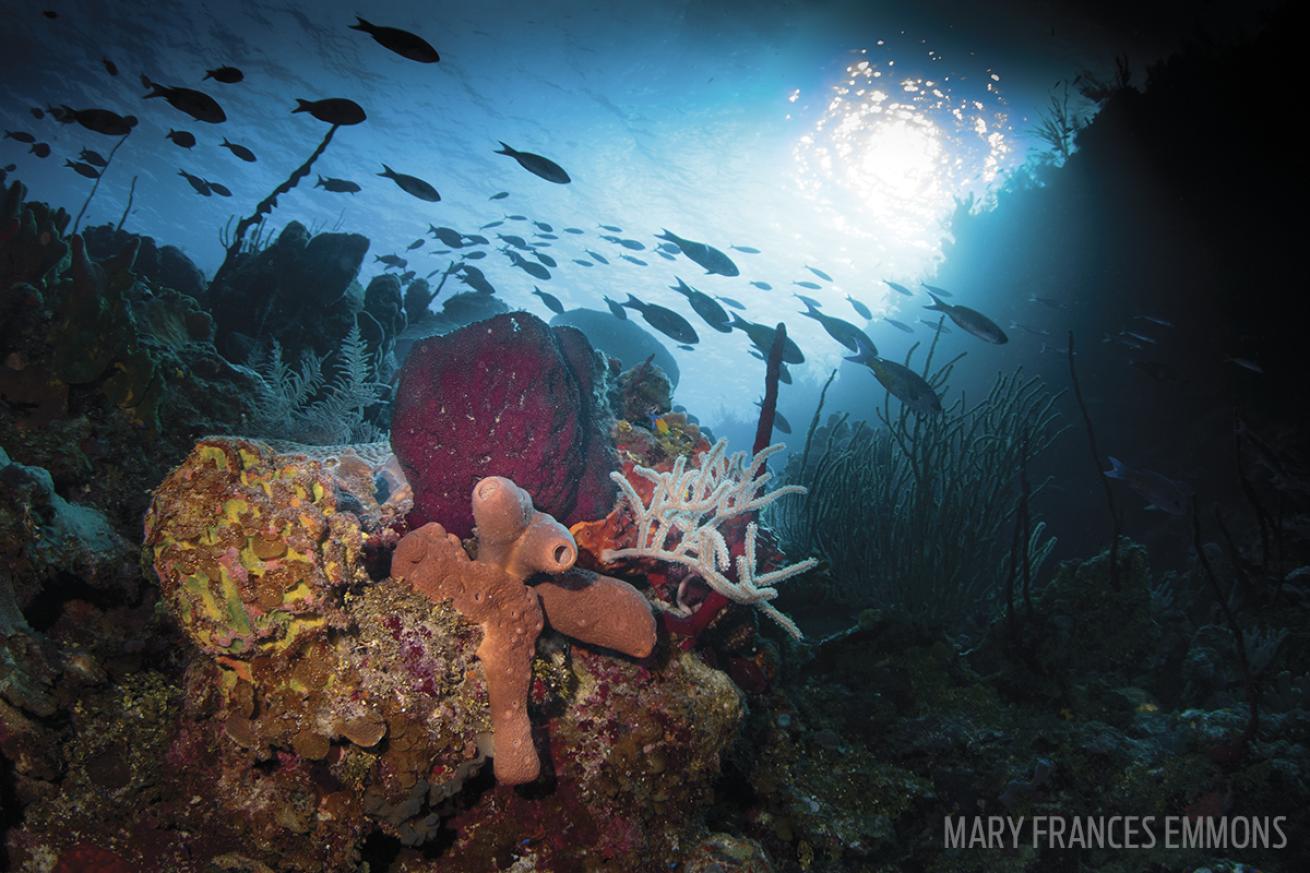
Mary Frances EmmonsA near-magical tool, Lightroom can be a force for good or evil, with its almost unlimited options for postproduction tinkering.
DAY FIVE
[7:30 a.m. Wednesday] Everybody’s on the dock and ready to go. From Backscatter groupies to divers new to photography, all are united in their love of underwater imagery and their willingness to work hard to improve their pictures. It’s humbling, and inspiring.
Little Cayman has some of the most beautiful diving in the world. But sometimes Mother Nature just won’t let you get to the best spots. At a site nobody is excited about, I descend and begin casting about for a picture, silently vowing to show greater respect to the pro shooters who labor under conditions they can never control to fill the pages of this magazine. Results are meh, but I note again one of the values of a Backscatter boot camp: camaraderie. At that night’s critique, nobody has anything good — whoopee, it’s not just me! — but everybody has fun ribbing each other. “Getting good in post makes you better in the water because you get tired of fixing the same stuff,” Quigley says.
DAY SIX
[10 a.m. Thursday] “What did we say last night?” Decker asks, recalling too many underlit shots. “STROBES?” he barks. “UP!” we shout. “STROBES?” “UP!” “STROBES?” “UP!” All dissolve in laughter.
It’s the last few dives, and I’m starting to get it. It’s seductive, peering into the viewfinder and seeing something wonderful. I begin to understand the pull of underwater photography, the sense of accomplishment that makes it worth the investment, the learning curve, the hours of practice. On our next to last dive, my buddy’s misfortune — an uncharged battery — is my gain. “Time for your private lesson,” Decker tells me. We’re at the Meadows, one of my favorite sites in the world. Decker’s presence alone is a huge confidence booster, as he works with me on strobe positioning and swaps off modeling duties so he can review my shots underwater and show me in his camera the image he’s trying to help me get on mine. Finally, I nail it! As we clamber back aboard, he turns to me and mimics applause. I take a mock bow. A small moment, but to me it feels like winning the Medal of Honor.
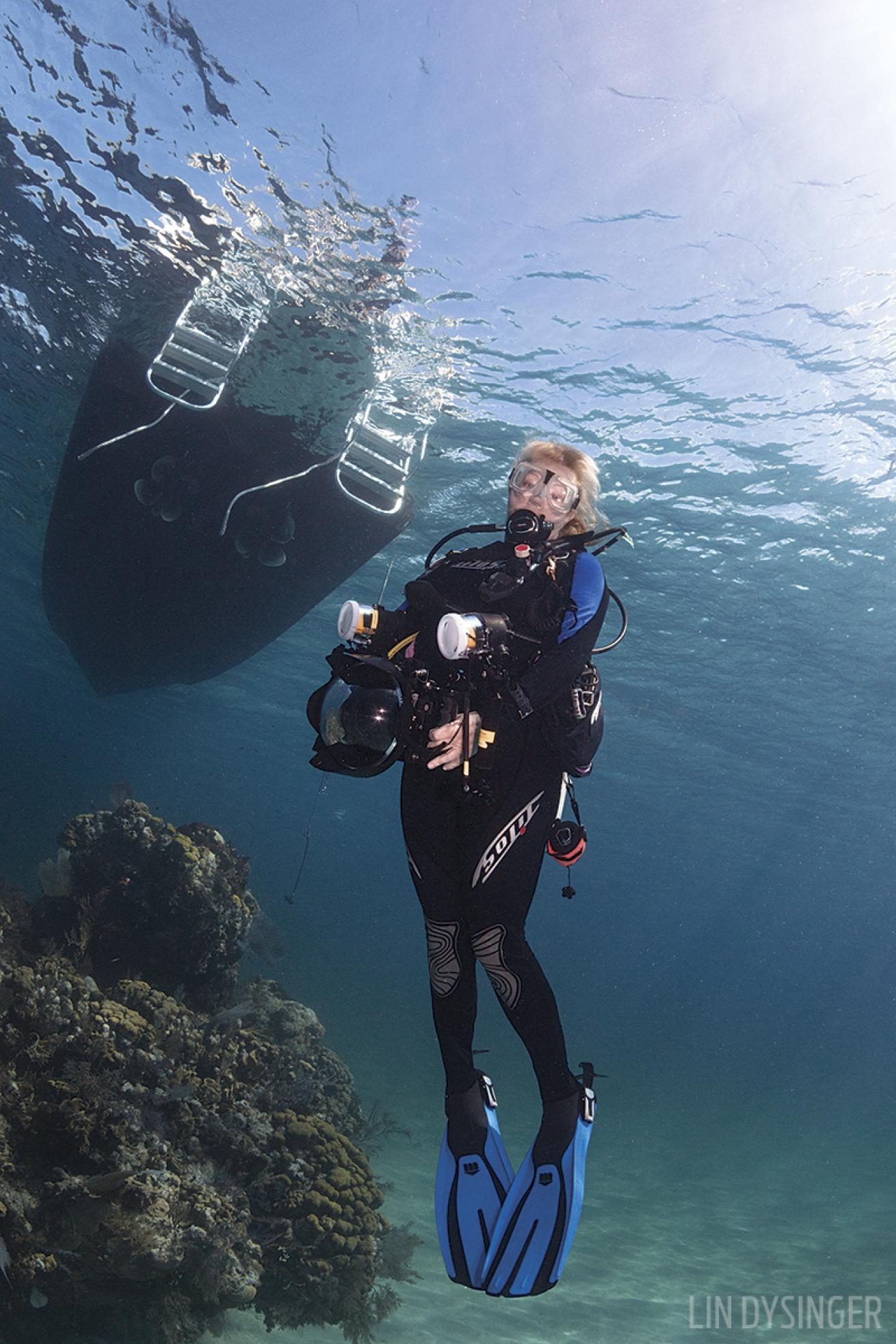
Lin DysingerThe author, on the last day at Little Cayman, shot by her dive buddy and fellow student Lin Dysinger.
6 REASONS TO ENLIST
1) One-on-one instruction.
2) Camaraderie. You’ll learn from your fellow students. (If you don’t, there’s always commiseration.)
3) Lightroom, OMG! You will feel like a Jedi Master.
4) Location, location, location.
5) Immersion therapy. Sure, you can skip sessions, but why would you?
6) Purpose-driven diving. All the cool kids are doing it.
BASIC TRAINING
What do you need to master before you arrive?
Be a good diver. You’ll avoid hurting Mother Earth, yourself and that expensive camera.
Know your camera in manual mode. None of that preset stuff — that’s for civvies. You’re in the marine corps now, son.
Know what you are looking at. Underwater objects look very different when lighted; don’t waste time on subjects that won’t look any better with light. Examining magazines like this one can be a place to start recognizing good subjects.
Accept your poolee status (look it up) until you’ve earned your stripes. When the sarge says stick with the sponges, he has a reason.
WHERE TO SIGN UP
Backscatter will offer a Wide-Angle Boot Camp at Little Cayman Beach Resort April 7-14, 2018. Cost is $2,999 per person, double occupancy, and includes seven nights’ accommodations, meals excluding drinks, daily boat dives, and daily seminars on wide-angle techniques and image processing, including in-water shooting help. A second week, April 14-21, will focus on advanced Lightroom techniques for wide-angle images and build on the skills learned the first week; package details are the same.

